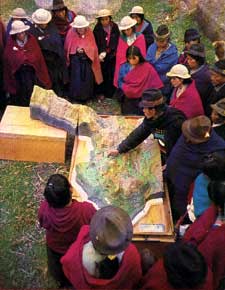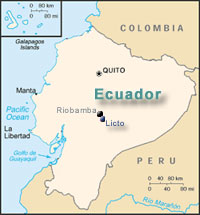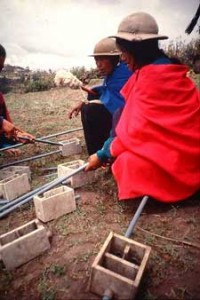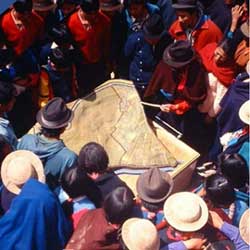Participatory 3D Modelling for Water Rights and Empowerment, Licto, Ecuador

 The scale models used in the interactive design of the Licto-Guarguallá Irrigation System involved the would-be water users in decisions about the technical, organizational and normative framework of the facility.
The scale models used in the interactive design of the Licto-Guarguallá Irrigation System involved the would-be water users in decisions about the technical, organizational and normative framework of the facility.
Models of different scales and application were particularly useful to generate interaction among water users (most of them female, many of them non-Spanish speaking and/or illiterate without irrigation design background), local farmer leaders and project staff.
The multiple indigenous peasant communities were enabled to visualize and collectively discuss their irrigation future.
The all-encompassing 3D model at 1:10,000 scale (3x vertical exaggeration) was brought to each of the numerous communities in the Licto-Guarguallá Irrigation System, in order to interactively discuss with the community members, particularly female farmers, their design needs and wishes, and the strategies to strengthen inter-community system design, construction and management. Discussion about farmers’ optimal design and implementation strategies and rights definition are facilitated by local (female) water user leaders, in local language (quichua), in farmers’ own community, avoiding trainers’ or engineers’ offices and technicist talk and drawings
Larger scale models (maqueta modular) were made for different hydraulic blocks (or tertiary unit) at 1: 400 scale with a 2X vertical exaggeration.
Once the general system design was defined among farmers, farmer leaders and project staff, new interactive strategies and tools are used to discuss canal lay out at the hydraulic block or community level.
During the discussions about irrigation design at community level, many new technical and organizational issues were brought to the fore by the future water users, which were incorporated in the final design and construction proposals. At the same time they got a clear and collective understanding of their future water use system.
In order to come to a collective discussion about and understanding of the functioning of the irrigation system and its elements a new, decomposable (puzzle) scale model was developed, the pieces of which were to be put together by future water users in a small area representative of their community.
 Particularly female water users, most of them illiterate and without previous experience in irrigation, could join the design exercises and see and discuss the consequences of design choices and alternatives, in their own community and in local language
Particularly female water users, most of them illiterate and without previous experience in irrigation, could join the design exercises and see and discuss the consequences of design choices and alternatives, in their own community and in local language
Recommended references:
Rutgerd Boelens. 2005. Water rights and participatory irrigation development : the case of Licto, Ecuador. IAPAD.
Boelens R., Hoogendam P. (eds), 2002. Water rights and empowerment. Royal Van Gorcum Publishers, Assen, The Netherlands
Boelens R., Davila G. (eds). 1998. Searching for Equity Conception of Justice and Equity in Peasant Irrigation. Royal Van Gorcum, Assen, The Netherlands. 472 pp.
Video production: “The Right to be Different: Struggle for Water and Identity in the Andes”
In the parish of Licto, near Riobamba, in Ecuador, the indigenous population fought for its water. Indian peasants participated in the design, construction and organisation of the irrigation system. After more than 20 years the water finally reached the community. The story is told by Inés Chapi, an Indian woman, who came a long way from being oppressed and discriminated against to become a most respected irrigation organiser in the system. In the Andes they call it blood of the earth, the source of life from which other life grows. Water, feeding the land as well as the imagination. Giving rise to rituals and myths, fueling tradition and culture. Ancient and modern conquerors of these highlands denied the indigenous people access to springs and rivers. Water became a source of conflict. And usually the Indians got a raw deal.
Based on: The Rules of the Game and the Game of the Rules’ by Rutgerd Boelens; Executive producer and scenario: Barend Hazeleger; Photography: Thom Deelstra; Sound recordist: Juio Gorck; Editing: Jan Pieter Tuinstra & Barend Hazeleger; Scientific research and Interviews: Rutgerd Boelens; Produced by Agrapen and Wageningen University (2003)

Follow us!